
Science with Passion
Application No.: VPH0075 Version 1 02/2021
Determination of retention behavior of cannabis extract by column screening
Simona Felletti2, Yannick Krauke1, Svea Stephan1, Kate Monks1; applications@knauer.net
1 KNAUER Wissenschaftliche Geräte GmbH, Hegauer Weg 38, 14163 Berlin;
2 University of Ferrara, Department of Chemical, Pharmaceutical and Agricultural Sciences
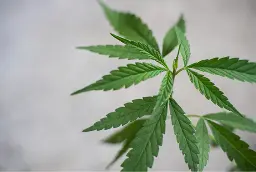
Summary
The need of high purity cannabinoids is continuously growing. For this reason, it is of fundamental importance to find high selective and efficient methods for their purification. In this application, the separation of six cannabinoids contained in a crude CBD extract has been evaluated on six analytical columns with four different mobile phase compositions under normal phase conditions. The information obtained could be useful for the set-up of following purification steps.
Introduction
In the last years, the growing interest of cannabis and its related products for both medicinal and recreational use has led to the development of different techniques able to separate and purify cannabinoids. Among all phytocannabinoids, (-)-trans-Δ9-tetrahydrocannabinol (Δ9-THC) and (-)-trans-cannabidiol (CBD) are the most abundant and studied. Δ9-THC is known to have psychoactive effects, while CBD, non-psychoactive, is characterized by many therapeutic medicinal properties, such as anti-inflammatory and, antioxidant effects, to name but a few1,2,3,4. CBD purification from hemp extracts could be challenging due to large number of other components such as terpenes, waxes, cannabinoids, etc.. For some medical applications, the complete removal of Δ9-THC is required in order to obtain highly pure CBD. In this work, a set of six analytical columns with different modifications has been tested under normal phase (NP) conditions in order to have an overview of the retention behaviour of the main cannabinoids present in a crude CBD extract. This study has provided the best separation conditions for the crude mixture (in terms of mobile and stationary phases) in an analytical scale. A useful information for purification purposes.
Results
The CBD sample (original and decarboxylated) was analysed with the previously described reverse phase (RP) method5. The chromatograms are shown in Fig. 1.

Fig. 1 Overlay chromatograms of the original CBD sample (green), the decarboxylated CBD sample (blue) and 16 cannabinoids standard mixture. Positive identified substance peaks are highlighted with * in the original sample. The concentration of the two samples is 12 mg/ml; 2 μl injection, 228 nm; C18P, 3 μm, 150 x 4.6 mm ID, analytical RP method. The slight shift in retention for the last eluting compounds present in the two samples with respect to the standard mixture depends on the different solvent in which they are dissolved (samples: heptane, standards: methanol).
Most impurities eluted within the first five minutes. An overlay of the chromatograms of the sample and the mixture of 16 cannabinoids, as well as a subsequent retention time comparison led to the identification of ten cannabinoids: CBDV, CBDA, CBGA, CBG, CBD, CBN, Δ9 -THC, CBL, CBC and CBCA. A five-point calibration curve for the major cannabinoids (CBD, CBDA, Δ9 -THC, THCA, CBL, CBC, CBN, CBG) was measured and the resulting coefficients were above R>0.999 for all cannabinoids (Fig. 2).
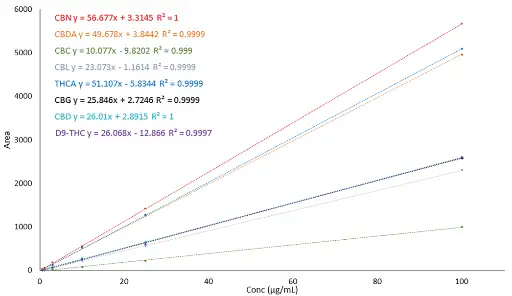
Fig. 2 Calibration curves and linearity for the cannabinoids CBD, CBG, CBDA, CBN, Δ9 –THC, THCA, CBC and CBL for analytical RP method at
228 nm.
The calibration was used for the analysis of the two CBD samples. The area %, calculated at 228 nm, was used to quantify the purity of the identified cannabinoids. The results show that, in the original sample, CBDA and CBD are the most abundant cannabinoids with approximately 40.9% and 30.7% (area), while in the decarboxylated sample the CBD purity is 65% (area). The calculated cannabinoid contents (expressed as % w/w) in the two samples are shown in Tab. 1.
Composition (% w/w) of the original and the decarboxylated samples and comparison with manufacturer results
CBDA% | CBG% | CBD% | CBN% | THC% | CBL% | CBC% | |
Manufacturer | 5.50 | 0.23 | 6.18 | 0.07 | 0.15 | - | 0.55 |
Our results | 4.36 | 0.28 | 6.25 | 0.08 | 0.18 | 0.32 | 0.57 |
Decarboxylated | - | 0.24 | 7.90 | 0.15 | 0.10 | 0.18 | 0.50 |
After the analysis of the two samples, a column and mobile phase screening has been performed in order to find the best separation conditions under normal phase elution mode. Six columns (NH2, Diol, CN, C18, Phenyl and Si) and four mobile phase compositions (90:10 % v/v of heptane/isopropanol, heptane/ethanol, hexane/isopropanol and hexane/ethanol) have been applied.
Results
C18 and Phenyl columns were not used for the complete study since no separation was observed under these experimental conditions (Tab. 2).
Comparison between separation efficiency of the six columns: Bad separation (-), further optimisation needed (+-), good separation (+), very good separation (++), n/a: no separation.
90:10 % | NH2 | CN | Diol | C18 | Phenyl | Si |
Heptane/IPA | + | + | +- | n/a | n/a | - |
Heptane/EtOH | +- | ++ | ++ | n/a | n/a | +- |
Hexane/IPA | ++ | + | +- | n/a | n/a | - |
Hexane/EtOH | +- | ++ | ++ | n/a | n/a | +- |
Fig. 3 and Fig. 4 show, as an example, the separation of the decarboxylated sample on NH2, Diol, CN and Si columns with 90:10 % v/v heptane/isopropanol and 90:10 % v/v heptane/ethanol mobile phases. The identification of the peaks was obtained through the comparison of the chromatograms of the CBD sample and six cannabinoid standards, namely CBD, CBG, CBN, Δ9–THC, CBC and CBL. If all the six cannabinoids are considered, the best separation with heptane/isopropanol as mobile phase was achieved with CN and NH2 columns (Fig. 4).
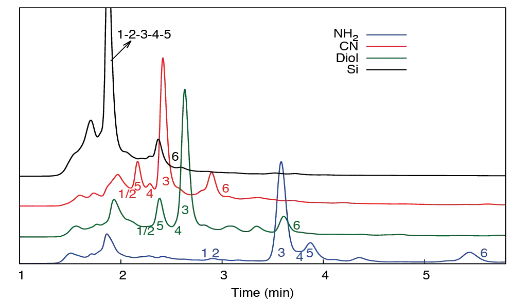
Comparison between chromatograms of decarboxylated CBD sample obtained with NH2 (blue), Diol (green), CN (red) and Si (black) columns under NP conditions. Mobile phase = 90:10 % v/v heptane/isopropanol, flow rate = 1 ml/min, injection volume = 3 µl,
injected concentration = 12 g/l. 1: CBL, 2: Δ9 –THC, 3: CBD, 4: CBN, 5: CBC, 6: CBG.
Conversely, ethanol as polar modifier leads to better resolution for CN, Diol and Si columns, but worse for NH2 column if compared to isopropanol (Fig. 4).
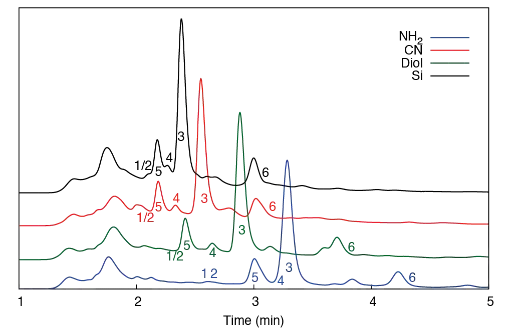
Comparison between chromatograms of decarboxylated CBD sample obtained with NH2 (blue), Diol (green), CN (red) and Si (black) columns under normal phase (NP) conditions. Mobile phase = 90:10 % v/v heptane/ethanol, flow rate = 1 ml/min, injection volume = 3 µl,
injected concentration = 12 g/l. 1: CBL, 2: Δ9 –THC, 3: CBD, 4: CBN, 5: CBC, 6: CBG.
Nevertheless, independently from the composition of the mobile phase, all the columns considered, except for the Si column, are able to separate Δ9–THC and CBD easily. With all columns, hexane leads to a slightly higher resolution and slightly smaller retention if compared to heptane, as shown in Fig. 5 for NH2 column.
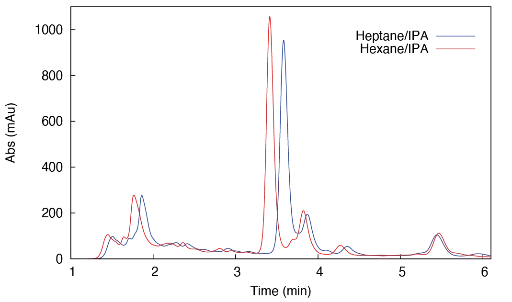
Chromatograms obtained on NH2 column with 90:10 % v/v heptane/isopropanol (blue) and hexane/isopropanol (red) mobile phases.
However, heptane/isopropanol mixture was chosen as mobile phase for this separation problem. On the one hand, heptane shows lower toxicity and hazard if compared to hexane. On the other hand, isopropanol leads to a reversed elution order of CBD, CBN and CBC on the NH2 column (peaks 3, 4 and 5) with respect to ethanol with clear advantages for purification purposes. After the screening, Si and Diol columns were excluded due to their poor resolution for target substances and late eluting compounds (> 20 min) for the latter (data not shown), while CN and NH2 columns were selected for further optimisation of the separation. In Fig. 6 and Fig. 7 chromatograms of the standards and the sample obtained with optimized mobile phase conditions are shown for NH2 and CN columns, respectively. The composition of the mobile phase was 92:8 % v/v for NH2 column and 95:5 % v/v for CN column.
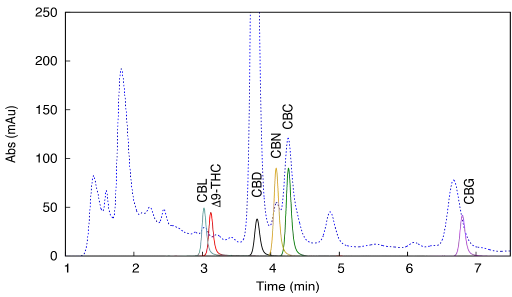
Detailed view overlay of decarboxylated CBD sample and single standard chromatograms obtained with NH2 150 x 4.0 mm, 5 µm column with 92:8 % v/v heptane/isopropanol mobile phase (NP method). CBD sample (dashed line) 12 mg/ml, standards (full line) 10 μg/ml.
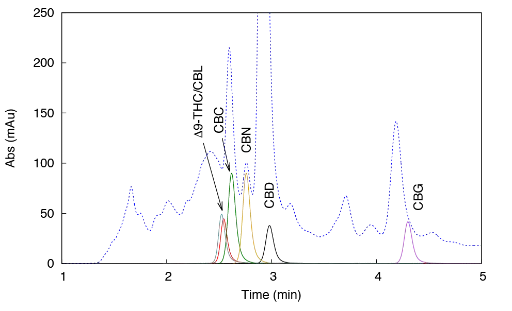
Detailed view overlay of decarboxylated CBD sample and single standard chromatograms obtained with CN 150 x 4.0 mm, 5 µm column with 95:5 % v/v heptane/isopropanol mobile phase (NP method). CBD sample (dashed line) 12 mg/ml, standards (full line) 10 μg/ml.
Sample Preparations
A CBD-rich extract, obtained with supercritical CO2 extraction method, was kindly donated by MH Medical Hemp GmbH. The sample mainly contained CBDA and CBD, 4% and 6% (w/w), respectively (see Tab. 1). A sample decarboxylation was performed to convert acidic cannabinoids into neutral cannabinoids. Different reactors, temperatures and amounts of sample were tested. The decarboxylation kinetic showed, as expected, a high dependence on the heating temperature. On the one hand, low temperature (ex. 80 °C) leads to slower kinetics and smaller CBD degradation. On the other hand, too high temperature (ex. 150 °C) leads to fast decarboxylation but larger CBD degradation. Therefore, a temperature of 120 °C was chosen. The decarboxylation kinetic of CBDA measured in the oven at 120 °C with open reactors is shown in Fig. 8 for different amounts of sample. For the analytical methods, a defined amount of sample was diluted in heptane and filtered through 0.2 μm PTFE syringe filter prior to injection. Cannabinoid calibration standards were prepared from 1 mg/ml cannabinoid standard solution (Tab. 3) and diluted with methanol to indicated concentrations. The standards were prepared in two mix solution, mix 1 (CBD, CBDA) and mix 2 (Δ9 -THC, THCA, CBL, CBC, CBN, CBG). A five-point calibration curve with 0.5 μg/ml, 3 μg/ml, 10 μg/ml, 25 μg/ml, and 100 μg/ml of each of the eight cannabinoids was established.

Kinetic study obtained at 120 °C in open reactors of the amount
(% w/w) of CBD (full points) and CBDA (empty points) as a function of time and the heated amount of sample (10 g: blue, 15 g: red and 20 g: green).
Conclusion
In this study the separation capacity of a set of six analytical columns, namely NH2, CN, Diol, Si, C18 and Phenyl, has been evaluated on a variety of mobile phase compositions for a crude CBD extract under normal phase conditions. On the one hand, the results showed that CN, NH2 and Diol columns were able to easily separate Δ9–THC from CBD under all the experimental conditions. On the other hand, it has been demonstrated that a mobile phase made of heptane/isopropanol can lead to a reversion of the elution order of CBD-CBN-CBC cannabinoids on the CN and NH2 columns with clear advantages for purification purposes.
References
Russo, E. B. Cannabidiol claims and misconceptions. Trends Pharm. Sci. (2017).
Zhornitsky, S., Potvin, S. Cannabidiol in humans: the quest for therapeutic targets. Pharmaceuticals. 5(5): 529–552 (2012).
Williamson, E. M., Evans, F. J. Cannabinoids in clinical practice, Drugs 60 1303–1314 (2000).
Krauke, Y., Monks, K. Purify CBD and other cannabinoids by preparative HPLC. KNAUER Wisschenschaftliche Geräte GmbH (2020).
[5] Loxterkamp, L., Monks, K. (C)an(n)alyze: determination of 16 cannabinoids inside flowers, oils and seeds. KNAUER Wissenschaftliche Geräte GmbH (2020)
Materials and Methods
Tab. 3 Material
Standard | CAS |
Δ9-tetrahydrocannabinol | 1972-08-3 |
Cannabidiol | 13956-29-1 |
Cannabidiolic acid | 1244 -58 -2 |
Cannabigerol | 25654-31-3 |
Δ9-tetrahydrocannabinolic acid | 23978-85-0 |
Cannabichromene | 20675 - 51- 8 |
Cannabinol | 521-35-7 |
Cannabicyclol | 21366-63-2 |
CBD sample | Hemp extract batch 40, product sample |
Tab. 4 Method parameters for analytical RP
Column Eurospher II | 100-3 C18P 150 x 4.6 mm, 3 µm |
Column temperature | 25 °C |
Injection volume | 2 µl |
Injection mode | Partial loop |
Detection | UV 228 nm |
Data rate | 10 Hz |
Tab. 5 Pump parameters for analytical RP
Eluent A: H2O + H3PO4 (85%) pH 2.2 | Eluent B: ACN | ||
Flow rate | 1 ml/min | gradient | |
Pump program | 25% | 75% | 0 - 7 min |
10% | 90% | 7 – 17 min | |
10% | 90% | 17 – 19 min | |
25% | 75% | 19 – 25 min |
Tab. 6 System configuration for analytical RP
Instrument | Description | Article No. |
Pump | AZURA P6.1L | |
Autosampler | AZURA AS 6.1L | |
Detector | AZURA DAD 2.1L Measuring cell: Pressure proof 10 mm, 10 µl | |
Thermosthat | AZURA CT 2.1 | |
Column | Eurospher II 100-3 C18P | |
Software | ClarityChrom 8.2.3 |
Method parameters for analytical NP
Column Eurospher II | 100-5 150 x 4.6 mm, 5 µm |
Column temperature | 25 °C |
Injection volume | 3 µl |
Injection mode | Partial loop |
Detection | UV 228 nm |
Data rate | 10 Hz |
Pump parameters for analytical NP
Eluent A: Heptane – Hexane | Eluent B: Ethanol – Isopropanol | ||
Flow rate | 1 ml/min | isocratic | |
Pump program | 90% | 10% |
System configuration for analytical NP
Instrument | Description | Article No. |
Pump | AZURA P6.1L | |
Autosampler | AZURA AS 6.1L | |
Detector | AZURA DAD 2.1L Measuring cell: Pressure proof 10 mm, 10 µl | |
Thermostat | AZURA CT 2.1 | |
Multi-position valve | VU 4.1L | |
Column | Eurospher II 100-5 CN Eurospher II 100-5 Phenyl Eurospher II 100-5 Si Eurospher II 100-5 NH2 Eurospher II 100-5 C18 | |
Software | ClarityChrom 8.2.3 |
Application details
Method | HPLC |
Mode | RP/NP |
Substances | CBD, CBDA, CBG, CBN, Δ9–THC, THCA, CBC, CBL |
CAS number | 13956-29-1, 20675-51-8, 1972-08-3 |
Version | Application No.: VPH0075 Version 1 02/2021 | ©KNAUER Wissenschaftliche Geräte GmbH |


